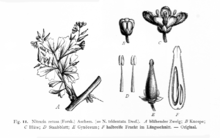Nitraria retusa
| Nitraria retusa | |
|---|---|
 | |
| N. retusa, from Vegetation der Erde (1910) | |
| Scientific classification | |
| Kingdom: | Plantae |
| (unranked): | Angiosperms |
| (unranked): | Eudicots |
| (unranked): | Rosids |
| Order: | Sapindales |
| Family: | Nitrariaceae |
| Genus: | Nitraria |
| Species: | N. retusa |
| Binomial name | |
| Nitraria retusa (Forssk.) Asch. | |
Nitraria retusa is a salt-tolerant and drought-resistant shrub or bush in the family Nitrariaceae. The plant grows to 2.5 metres (8 ft 2 in) tall, although it is usually less than 1 m in height. It has tiny, white to green, fragrant flowers,[1] and small edible red fruit.[2] The plant is native to desert areas of northern Africa, where it grows in primary succession on barren sand dunes,[3] and in areas with high salinities such as salt marshes.
Description
Nitraria retusa is a much-branched bush growing to a maximum height of about 2.5 m (8 ft). The twigs are downy when young, the bluish-grey fleshy leaves being alternate, wedge or sickle-shaped, with entire margins and measuring 10 to 15 mm (0.4 to 0.6 in) by 8 to 10 mm (0.3 to 0.4 in). The small, sweetly-scented, whitish or greenish flowers have short pedicels and parts in fives. The fruit is a triangular drupe, 5 to 10 millimetres (0.2 to 0.4 in) in diameter.[1]
Distribution and habitat
This plant is native to North and East Africa, the Arabian Peninsula and the Middle East. It typically grows in salt marshes and semi-arid saline areas of deserts and it can help in the stabilisation of loose soils.[4]
Ecology
In the Moghra Oasis, N. retusa plays an important role in the stabilisation of sand dunes. Here it is the dominant plant in some zones, forming hummocks known as nabkhas, where windblown materials heap up at the base of the plants. It shows a range of tolerances toward soil salinity and the availability of water. Near the lake, where salinity is low and the water table high, it associates with the sea rush, the common reed, salt grass and Zygophyllum album. At the outer fringe of the vegetated zone, where the salinity is high and the water table deep, it grows with Z.album and the Nile tamarisk.[5]
Uses
The fruit turns red as it ripens and is enjoyed by humans and wildlife, which spread the seed.[6] Camels and goats feed on the succulent leaves of this plant and desert-dwellers have used it as a source of salt. The wood is used for fuel and the fruits are sometimes used to make an intoxicating drink.[4] N. retusa is one of a number of salt-tolerant plants that are being investigated as potential fodder crops for livestock.[7]
References
- 1 2 "Nitraria retusa". Flora of Pakistan. eFloras.org. Retrieved 3 February 2016.
- ↑ Centre for Mediterranean Cooperation. A guide to medicinal plants in North Africa. International Union for Conservation of Nature and Natural Resources. p. 256. ISBN 978-2-8317-0893-5.
- ↑ Zahran, M.A.; A.J. Willis (2008). The Vegetation of Egypt. Springer. p. 440. ISBN 978-1-4020-8755-4.
- 1 2 Kubitzki, Klaus (2010). Flowering Plants. Eudicots: Sapindales, Cucurbitales, Myrtaceae. Springer Science & Business Media. pp. 273–275. ISBN 978-3-642-14397-7.
- ↑ Zahran, M.A.; Willis, A.J. (2013). The Vegetation of Egypt. Springer Science & Business Media. p. 69. ISBN 978-94-015-8066-3.
- ↑ "Nitraria retusa, Nitraria tridentata, Salt tree". Flowers in Israel. Retrieved 3 February 2016.
- ↑ Mold, Robert J. (2012). Ecology of Halophytes. Elsevier. p. 579. ISBN 978-0-323-14437-7.